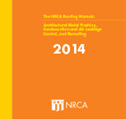Proper quality assurance during roof system installation can be an important element for long-term performance.
Quality assurance—unlike quality control, which is performed by roofing contractors—is the responsibility of a building owner or his or her designated representative, such as a licensed design professional, roof consultant or general contractor. The purpose of quality assurance is to verify the scope and intent of a project's contract documents are being met and roof system materials are being installed in accordance with contract documents, manufacturers' installation instructions and accepted industry practices.
NRCA asserts the most effective means of providing quality assurance is by visually observing materials and procedures used at the time of roof system installation. The person performing visual observation often is referred to as a quality-assurance observer (QAO).
ASTM D7186
ASTM D7186, "Standard Practice for Quality Assurance Observation of Roof Construction and Repair," establishes the role and responsibilities of those performing quality-assurance observation, as well as procedures for observation and reporting.
A QAO's function is to provide on-site observation and reporting of a roof system's construction process in a clear, accurate and objective manner; a QAO should not direct or order any work. A QAO should:
- Observe and record the general condition of the job site and roof areas under construction and materials used and stored
- Note pre-existing property damage or damage that can occur and the substrate condition and repair or replacement procedures
- Observe and record the installation of roofing materials and any other components specified in the contract documents, and flashing installation and detailing
- Record weather conditions, roofing crew size, foreman's name and all job-site visitors
A QAO should prepare a daily written report with photographs; this report should be made available to all parties involved in the roofing project. A copy of the report should be provided to the roofing contractor no later than the commencement of work the following day. ASTM D7186 includes sample pre-construction damage, material delivery, daily construction and progress summary, and unit cost tracking report forms for use by QAOs when completing the documentation necessary to provide proper quality assurance.
A QAO also should keep on-site copies of contract documents, including project specifications, the roof plan, construction detail drawings and any addenda, as well as stamped material submittals and minutes from the pre-bid, pre-construction and project meeting minutes.
A QAO is responsible for providing and maintaining the tools and equipment required to perform his or her work, including any necessary safety equipment, such as personal protective equipment and fall protection. A QAO should follow all applicable safe work practices.
A QAO or the firm providing the quality-assurance observations must provide insurance and submit a certificate of insurance showing coverage for workers' compensation, comprehensive general liability, automobile insurance and, if applicable, professional liability insurance. Insurance limits shall be the statutory amounts or higher amounts if required in the contract.
NRCA guidelines
ASTM D7186 references the following NRCA documents that provide industry-accepted guidelines for evaluating roof system application:
- Quality Control Guidelines for the Application of Built-up Roofing
- Quality Control Guidelines for the Application of Polymer-modified Bitumen Roofing
- Quality Control Guidelines for the Application of Thermoset Single-ply Roof Membranes
- Quality Control Guidelines for the Application of Spray Polyurethane Foam-based Roofing
- Quality Control Guidelines for the Application of Asphalt Shingle Roof Systems
NRCA recommends these documents be used with ASTM D7186 to provide effective quality assurance.
When a QAO will be present on a job site, NRCA recommends his or her role be clearly defined and understood by all parties, including the building owner, licensed design professional, general contractor or construction manager, and roof consultant. NRCA encourages referencing ASTM D7186 for this purpose.
All NRCA documents referenced can be purchased by accessing the NRCA Bookstore at shop.nrca.net.
Mark S. Graham is NRCA's associate executive director of technical services.



